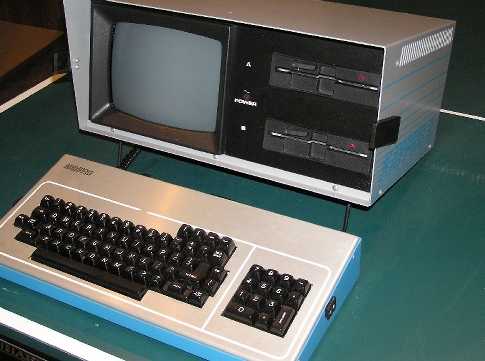|
of them (Kaypro IV & 10) were used by doctors for the Paris-Dakar 84's edition. None of them failed despite
extreme conditions.
One asset of the Kaypro over the Osborne 1, which was available at about the same time,
is the 9" built-in monitor, easily twice the size of the Osborne's. Though the Kaypro II has no graphic
features, it can display 80 x 24 characters. There are two single-sided / double-density full-height 5.25''
disk-drives (190k each). One can be used to boot CP/M and the other to run the software.
The Kaypro II is a real "luggable" system. Even if it weights more than 10kg, it can be easily moved with
the handle found at the back.
At the rear of the system, one can find a serial port, a parallel port, a keyboard connector, a brightness control
knob and a reset button.
Perfect Writer, Perfect Calc, Perfect Filer, Perfect Speller, S-Basic, CP/M and Profitplan were bundled with the
system. Later WordStar was also available.
As usual with Kaypro, the model names logic is quite dramatic to resolve. Several Kaypro "2" were marketed:
- In 1984 a new Kaypro II (referred as Kaypro 2'84) was introduced. It had two SS/DD half-height floppy drives, a Z-80A running at 4.0 MHz, 2 serial ports and rudimentary graphics (through graphic characters).
- The same year, the Kaypro IIX is released. Very similar to a Kaypro 2'84 but with DS/DD half-height drives.
- Still in 1984, in order to be compatible with IBM software, a special version was marketed with an Intel 8088 CPU
instead of the Z80A. It was called the Kaypro II Plus 88
- In 1985 another Kaypro II referred as "New 2" is sold. It is basically an old IIX motherboard, with one
or two DS/DD floppy drives, but no 300-baud modem previously found on the IIX. It comes with just CP/M and Wordstar
for software.
- And to spice up a bit things, Kaypro decides to rename its Kaypro IV'84 as Kaypro IIX (sometimes also known as
IIX MTC), thus dropping the previous IIX model.
In 1985, Arthur C. Clarke published a sequel to 2001: 2010 Odyssey Two. He worked with Peter Hyams in the movie
version of 2010. Their work was done using a Kaypro computer and a modem, as Arthur C. Clarke was in Sri Lanka and
Peter Hyams in Los Angeles. Their communications turned into the book The Odyssey File - The Making of 2010.
|





